Wildfires Disrupt Students’ Learning and Home Communities
As record-breaking wildfires continue to burn in the Western United States, Dickinson students living in the region are dealing with the disasters’ effects in their online classes and home life. The fires’ co-occurrence with the coronavirus pandemic is also creating new limits on daily activities.
Olivia Buckley ’22, who lives outside of Portland, Or., was forced to evacuate her home early in the school year. The Air Quality Index (AQI) was at 500—the maximum hazardous level—for a week, and her house did not have an adequate filtration system.
“I also was unable to do any traveling or any outdoor activities for three weeks in September, which took a toll on me and my roommates[‘] plans for traveling,” Buckley added in a written response.
South of Oregon in Santa Monica, Ca., Halle Maeda ’21 has had difficulty completing schoolwork. “The wildfires have impacted my ability to go out in the field and properly do my lab portion of my class,” she wrote.
Maeda has also faced stress from a “scary and sudden situation” within her family—her sister needing to evacuate her home in Northern California. “Her figuring out what to take and leave in a short amount of time is super stressful,” Maeda wrote. “She was lucky enough to have friends that she could stay with and her place did not get hit by the fire.”
The effects of the air quality have also extended to students’ extracurricular activities. Ayinde Summey ‘21 is training as a member of Dickinson’s Cross Country/Track and Field team. At his home in Colorado, the compounded effects of the Cameron Peak Wildfire—the largest in state history—and a drought are hindering his ability to run.
“It’s difficult to train during the pandemic[,] especially when the air quality varies from good to very bad at any given time,” Summey wrote.
The threat of this year’s wildfires, and the resulting decrease in air quality, has been exacerbated by the coronavirus, which affects the respiratory system. Several students reported that the fires had encouraged more members of their community to remain at home.
“With the fire and the pandemic going on at the same time most people are trying to stay inside…and stay healthy,” wrote Kayden Tucker ’22, a Los Angeles, Ca. resident.
In Portland, wrote Buckley, “it was hard because with COVID you cannot do anything inside like go to restaurants or museums. But because of the fires we then could also not do anything outside. This then impacted everyone’s health because you couldn’t even go outside as a stress relief…we truly were trapped in our house for about 2.5 weeks.”
When students have left their homes, they have observed harsh environmental effects.
“It’s common to smell [fire] when you go outside as well as ash blowing in the wind,” Summey wrote, describing the area near his Colorado home. “You can see the fires from Boulder and other cities and going on day hikes in the west, fire damage is clearly visible from a distance[,] and what looks like rain clouds are actually smoke clouds.”
This year marks a new level of destruction in seasonal wildfires. Over 4 million acres in California alone have burned, according to the Washington Post, and 5 of the top 18 most destructive fires on record have taken place in 2020.



